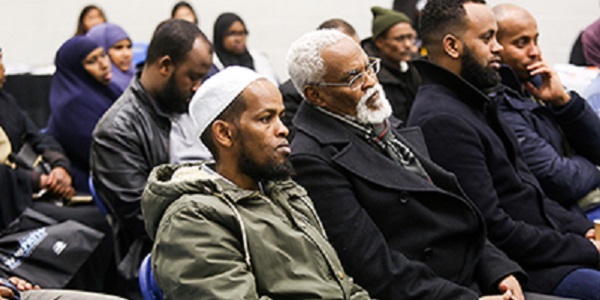SOMALIA USED TO BE a proud country in East Africa. It had strong links with the UK – not least because, as a seafaring nation, many Somalis sailed to the UK and some also served in the British Merchant Navy during the Second World War. Many sailors stayed at the Queen Victoria Seamen’s Rest in East India Dock Road.
During its period as the Somali Democratic Republic (1969 to 1991), Somalia mixed socialist and Muslim principles. It was notable for having one of the best community-based healthcare systems in Africa, as well as one of the highest literacy rates and a good education system. That collapsed in 1991, with the outbreak of civil war, since when the country has seldom been at peace and has not been able to maintain these standards.
The largest populations of Somali origin in the UK are in Tower Hamlets and Cardiff – another port which sailors frequently travelled to. It grew as sailors settled in the UK and brought their families over, or started new ones. Around the time the civil war broke out, there was also a new wave of refugees.
All this leaves Tower Hamlets with 2,025 residents who were born in Somalia (according to the 2011 censusus) – just over 1% of the population. The Council estimates that between 6,000 and 9,000 of the borough’s population has Somali heritage.
Like many ethnic minority communities in the borough, the Somali population has a history of voting Labour. This fell away during the years in which the Tony Blair Government led the UK into wars with Afghanistan and Iraq.
The Labour Group of Councillors includes Cllr Amina Ali, who has Somali heritage and may be the first Councillor of Somali heritage in Tower Hamlets. It is thought that Cllr Ali encouraged Executive Mayor John Biggs to target some resources on this community, to try to address some of the inequalities the community faces – and a year ago, Biggs set up a Somali Taskforce to deliver help to the community.
This is the level of inequality the Taskforce faced. In relation to Tower Hamlets residents who were born in Somalia, the 2011 census showed that:
•74% live in social housing (the figure for all residents is 44%);
•22% have a long-term health problem or disability (the figure for all residents I 14%);
•16% have higher level qualifications (the figure for all residents is 41%);
•34% of those of working age are in employment (the figure for all residents is 64%), with 48% of Somali-born workers being employed part-time (the figure for all residents is 20%).
The 2011 census also found that 31% of Somali households live in overcrowded households (the figure for all households is 16%).
On 1st February, the Taskforce celebrated its first anniversary and reported the achievements of its first year. The Council report on its work has only one quantified outcome: the Taskforce has registered more than 150 individuals for employment information, advice and guidance.
In addition, the Council has recorded some unquantified work which the Taskforce has completed:
•hosted an employment and training fair with WorkPath, the council’s partnership employment programme;
•supported individuals into securing employment and enterprise training;
•commissioned a history project, which has captured some of the experiences of Somali migration and settlement in the community through film, photography and digital mapping;
•created opportunities for Somali residents to train as market traders;
•increased participation in English for Speakers of Other Languages courses;
•introduced Somali language support in the council’s housing service;
•created links between community organisations and Somali residents and increased participation in activities for older people;
•delivered targeted social care information and advice to Somali residents.
Is this enough? Executive Mayor John Biggs’s verdict was somewhat ambiguous. “Tower Hamlets is home to a vibrant and well-established Somali community,” he said. “Our goals and ambitions in setting up the Tower Hamlets Somali Taskforce were clear from the start. We wanted to remove barriers, help Somali residents overcome some of the challenges they often face in accessing services and give members of the community opportunities to prosper and succeed. We know there is still more to be done, however many success stories are now emerging as a result of the extra steps we have taken to engage with and invest in the community and this is worth celebrating.”
Cllr Amina Ali, who chairs the Somali Taskforce, said, “I am proud we are tackling the challenges of the Somali community head on through the innovative Somali Task Force as a Mayoral priority. A marginalised community is now being given opportunities to reach their potential and prosper as part of our diverse, multicultural Tower Hamlets community. This is a Taskforce for Somali people, led by Somali people. ”
The Somali community is suffering from cuts in Council services, like many of the Borough’s least well off residents. The Taskforce may be helping to redress some of the inequalities between the Somali population and other disadvantaged groups. Whether its work will make any real headway in eradicating inequality between the Somali population and the bosses and bankers of Canary Wharf remains to be seen.
•Read more about it:
MPs deplore child poverty – but short on action
Oxfam report exposes growing wealth gap
[Adverts]
 East London News A Force for the community…
East London News A Force for the community…





